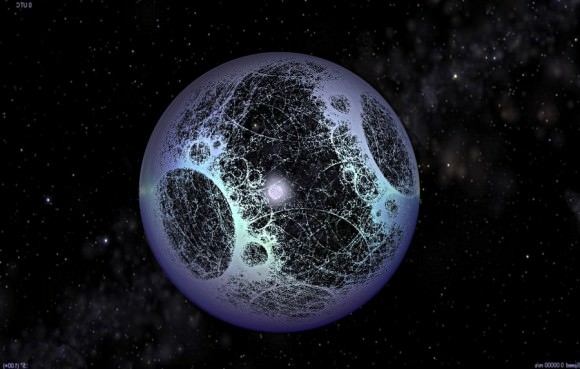We’re not saying its aliens, but this could be the most enticing SETI-related signal from space since the famous “Wow! Signal” in 1977.
Over the weekend, interstellar expert Paul Gilster broke the news that “a strong signal” was detected by Russian radio astronomers from the region around the star HD 164595. This signal has attracted enough attention that two prominent SETI observatories are quickly making follow-up observations. Alan Boyle reports in Geekwire that the Allen Telescope Array in California has already been observing the star system and the Boquete Optical SETI Observatory in Panama will make an attempt this evening, if the weather is clear.
Doug Vakoch, the President of METI International (Messaging Extraterrestrial Intelligence) told Universe Today via email that the Allen Telescope Array has already completed its initial reconnaissance of HD 164595, “with no indications of alien technologies at radio frequencies.”
“The first step in following up a putative SETI signal is to look at the same frequency where it was first detected,” Vakoch said, and with the nil detection from the ATA, “now it’s time to search other parts of the electromagnetic spectrum.”
Vakoch said METI International will be observing HD 164595 for brief laser pulses from the Boquete Optical SETI Observatory in Panama as soon as weather permits.
“It looks like the Boquete Observatory will be hit by heavy thundershowers late this afternoon and into this evening,” he said, “so we’ll likely need to wait to observe until another night. Once the evening sky is clear in Boquete, we’ll have about an hour to observe in the direction of the constellation Hercules shortly after sunset.”
The signal from HD 164595 was originally detected on May 15, 2015, by the Russian Academy of Science-operated RATAN-600 radio telescope in Zelenchukskaya, Russia. It is located about 95 light years from Earth in the constellation Hercules. The signal had a wavelength of 2.7 cm, with an estimated amplitude of 750 mJy.
Gilster wrote on his Centauri Dreams website that the researchers have worked out the strength of the signal and that if “it came from an isotropic beacon, it would be of a power possible only for a Kardashev Type II civilization,” which means a civilization capable of harnessing the energy of the entire star, and developing something like a Dyson sphere surrounding the star, and transfer all the energy to the planet.

If the beam was narrow and sent directly to our Solar System, the researchers say it would be of a power available to a Kardashev Type I civilization, a type of civilization more advanced than us that is able to harness the full amount of solar power it receives from its star.
Of course, like any other signal, such as the recent study of the dimming light curve of KIC 8462852 (Tabby’s Star) that is still being researched, it is possible the signal comes from other “natural” events such microlensing of a background source or even comets as been proposed for both Tabby’s Star or the “Wow! Signal.”
The SETI website explains that narrow-band signals – ones that are only a few Hertz wide or less – are the mark of a purposely built transmitter. “Natural cosmic noisemakers, such as pulsars, quasars, and the turbulent, thin interstellar gas of our own Milky Way, do not make radio signals that are this narrow. The static from these objects is spread all across the dial.”
And so Gilster said “the signal is provocative enough that the RATAN-600 researchers are calling for permanent monitoring of this target.” You can see a graph of the signal on Centauri Dreams.
Update: A member of the SETI@Home team posted a note online that they were “unimpressed” with the paper from the Russian radio astronomers. “Because the receivers used were making broad band measurements, there’s really nothing about this “signal” that would distinguish it from a natural radio transient (stellar flare, active galactic nucleus, microlensing of a background source, etc.) There’s also nothing that could distinguish it from a satellite passing through the telescope field of view. All in all, it’s relatively uninteresting from a SETI standpoint.”
So, this detection might not be as exciting as originally reported. Also SETI senior astronomer Seth Shostak has now weighed in on the topic, also with measured skepticism on the excitement, with a post about this event on the SETI website.
What has probably fueled interest in this signal is the striking similarities between the star and our Sun. HD 164595 is a star just a tad smaller than our Sun (0.99 solar masses), with the exact same metallicity. The age of the star has been estimated at 6.3 billion years it is already known to have at least one planet, HD 164595 b, a Neptune-sized world that orbits the star every 40 days. And as we’ve seen with data from the Kepler spacecraft, with the detection of one planet comes the very high probability that more planets could orbit this star.
The signal has been traveling for 95 years, so it “occurred” (or was sent) in 1920 on Earth calendars. (There is a good discussion of this in the comment section on Gilster’s article.)
Why the Russian team has only made this detection public now is unclear and it may have only come out now because the team wrote a paper to be discussed at an upcoming SETI committee meeting during the 67th International Astronautical Congress in Guadalajara, Mexico, on Tuesday, September 27.
As Gilster wrote, “No one is claiming that this is the work of an extraterrestrial civilization, but it is certainly worth further study.”
Sources: Centauri Dreams, Alan Boyle on Geekwire, SETI


As a kid growing up in the late 70’s and 80’s, I studied and loved learning everything I could about the universe. When I first read about the “Wow” signal as a middle school kid, I was blown away by it’s potential as a calling card from another species outside of Earth. I wrote school essays on the subject and it was interesting to me that some teachers have never heard of it (must have been all the drugs and free love movement in the 60’s that eroded their minds…hahaha). Anyway, long story short is that we may have stumbled across something as monumental as what we heard all the way back in 1977. Except now, we have much more advanced technological instruments and intelligence to possibly answer not one but both of these amazing anomalies. These signals may not be from an alien civilization after all and that’s ok. The knowledge we will gain by the studying this subject is well worth it. What an exciting time in the world of astronomy!
The statement: if “it came from an isotropic beacon, it would be of a power possible only for a Kardashev Type II civilization,” assumes that an advanced civilization would not have MASER technology that is more advanced than what we have.
That is not reasonable.